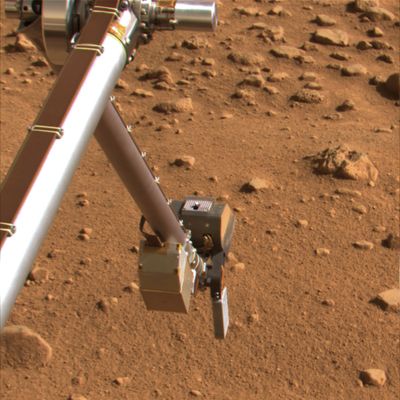NASA scientists find toxic chemical in Martian soil

New soil chemistry tests by NASA’s Phoenix Mars lander have unexpectedly uncovered evidence of perchlorate, a highly reactive salt found naturally on Earth and in a variety of products, including fertilizer, fireworks and rocket fuel, scientists said Tuesday.
While the finding has surprised scientists evaluating results from Phoenix, they denied that the presence of large amounts of the salt would render Mars uninhabitable.
“It might even be a positive” indicator for habitability, said Peter Smith, one of the lead scientists on the Phoenix mission.
On Earth, perchlorate is found most abundantly in the surface soils of Chile’s Atacama Desert, which ironically has long served as a Martian stand-in for researchers trying to understand conditions on Mars.
The 600-mile-long strip of land is roughly 50 times drier than Death Valley. Even so, it is not uninhabited. Microbes flourish there and some life forms even feed on the perchlorate in the soil.
“This is an important piece in the puzzle” surrounding Mars and its ability to sustain life, Smith said at a news briefing in Tucson, Ariz., where much of the Phoenix research is headquartered at the University of Arizona.
“In itself, it’s neither good nor bad for life,” he said.
Perchlorate was first detected several weeks ago with Phoenix’s on-board wet chemistry lab, which mixes water brought from Earth with Martian soils.
The scientific team held back the information while they tried to confirm the finding in a second on-board instrument, known as the Thermal and Evolved-Gas Analyzer, which can heat the soil up to 1,800 degrees Fahrenheit to determine its exact chemical composition.
Those tests remain incomplete, but NASA decided to publicize the discovery Tuesday after word spread that NASA was hiding evidence that Mars was hostile to life. The scientists on Tuesday denied they were being secretive, saying they wanted to consult with other scientists before publicizing the data.
The scientists said they were initially startled by the size of the chemical signal. Because it was so large, they at first discounted it, thinking the instrument had developed a problem. Some scientists felt it might even be picking up contamination from the rocket engines that carried Phoenix across 200 million miles of space from Earth to the vast rolling northern plains of Mars.
But the scientists on Tuesday tended to discount contamination because the craft’s descent engines use hydrazine, which doesn’t contain perchlorate. Also, no perchlorate was found when Phoenix calibrated the wet chemistry lab after its landing on the Red Planet May 25.
The wet chemistry lab is a set of four beakers into which water is injected to mix with the soil. A collection of 26 sensors then samples the mixture to analyze its contents.
Because perchlorate is so soluble in water, it is rarely found in surface soils on Earth. Even though Phoenix is sitting atop a vast underground sheet of hard-as-concrete ice, it hasn’t rained on Mars in billions of years.
As well as confirming the wet chemistry finding with the TEGA instrument, the scientists are trying to understand the mechanism that could deposit large amounts of perchlorate on the surface.